#squidthoughts
Explore tagged Tumblr posts
Text
Biology of Inkfish - Health
Notably, neocephalopods only possess an innate immune system and completely lack an adaptive immune system as seen in most fish - their immune systems are “non-learning”. This means that cephalings do not form immunities to diseases, nor do their immune systems protect them from diseases they have endured before. In comparison to organisms with an adaptive immune system, vaccines are redundant to cephalings, but on the positive side, allergies do not occur.
Common symptoms of disease in inkfish include headaches, changes in ink consistency, ink droughts, duller tentacle colors, muscle weakness, dizziness, wobbly movements and loss of appetite. Excessive ink bleed, low body temperatures, dry skin, fatigue, loss of coordination and general tiredness are also common symptoms of various infections. Sick individuals usually naturally seek out warm or even hot environments, and may spend excessive time in hot showers, underneath heated blankets or even the oven in ill-advised lapses of judgment. Raising the body temperature helps combat infection and beat illness faster, but can exacerbate symptoms of dehydration and be potentially dangerous to the brain and organs if not controlled.
Infections are easily transmitted through fresh ink or skin contact with other inkfish. As a result, infected inkfish are strictly banned from ink sports, as one Turf War with one infected player will almost certainly infect every player coming in contact with the ink.
Cephalings also encounter many conditions that aren’t necessarily caused by bacteria, such as cancers, muscle tears, beak chipping and growth abnormalities. Growth abnormalities may include quickly manifesting issues such as deep-sea gigantism or splitting or malformation of limbs. Abnormalities in limb growth most often occur when a limb is regenerating, but typically pose no risks.
An inkfish in poor health, mental or physical, will often have thin or droopy tentacles, reduced ink production and dull coloring. Some very common causes for these symptoms can be stress, poor mental health, very poor nutrition or disease.
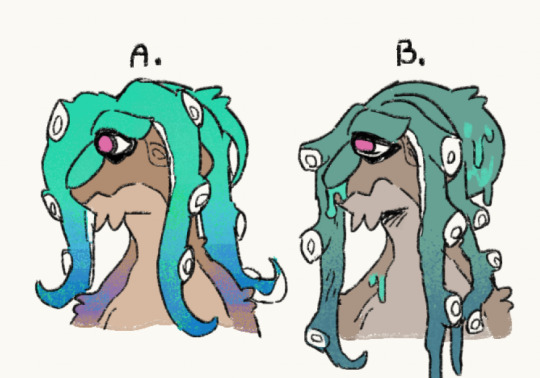
[The same inkfish when healthy (A) and when sick (B) exhibiting some common symptoms of illness. The most prominent symptom of any illness is desaturation of the skin.]
Regenerative Abilities
Cephalings are somewhat famous for their regenerative abilities and overall hardiness. Their bodies are incredibly flexible, and they have no bones - making them very impact-resistant. While they often sustain scratches and wounds thanks to their relatively thin skin, their regenerative abilities make up for many of their shortcomings.
In nature, neocephalopods would often lose limbs, from tips of the limbs to entire arms ripped off. This is a type of injury they are well adapted to, to the point that crown tentacles are even routinely cut off and minced for fashion purposes in the modern day. Wounds on the limbs bleed for a short time until the regenerative process begins; in inkfish, this window is even smaller due to ink bleeding out and helping to block the site of injury. Depending on whether the cephaling is healthy and gets proper sustenance, the limb often grows back in less than a year; in smaller species, it may grow back in even just a few months. Although cephalings can regrow their limbs as many times as they have to, it is quite common for mutations to occur, and the arm may split or grow in a strange shape.
Cephalings can regenerate a lot more than their arms - they can also regenerate parts of their organs, brains, and eyes to a lesser degree. Eyes can regenerate fully from shallow wounds, and partially from deeper wounds, to the point that an almost fully demolished eye can regenerate enough tissue to regain the ability to sense light. Minor brain- and heart injuries can also be regenerated, although with a higher margin of error with larger injuries that are still survivable. Damage to a branchial heart* is typically survivable, and the organs usually heal completely over time.
(* The branchial hearts are paired and are responsible for supplying blood to one gill each. Losing one entirely and surviving on just one gill is generally possible, although the reduced respiration poses some challenges.) Large injuries can still be lethal for cephalings. While losing one or more limbs isn’t particularly dangerous, situations where this happens as an effect of a predator attack often leave the cephaling unable to flee and thus cause them to get eaten. Injury to the systemic heart or the brain is also usually lethal within a short period of time. While they can regenerate limbs and organs, they are vulnerable to damage to the torso and mantle and are likely to perish from wounds that involve chunks being ripped off.
Common Ailments
Various ink infections. There are MANY kinds of infections that are caused when bacteria that really shouldn’t be in there get inside the ink sac. This typically causes atypical ink production and consistency, dizziness, possible body pains and ink droughts. Most ink infections are easily identified and are treated with antibiotics or gel that absorbs into the ink veins.
Ink bleed. A state in which ink bleeds out of the ink sac and the body involuntarily. It’s typically caused by the ink ducts being open involuntarily and abnormally, the body producing too much ink, the ink produced being too runny or a combination of several factors. It is usually a symptom of illness or abnormality of the ink sac.
Ink drought. The opposite of ink bleed. An ink drought is a condition where the ink sac produces much less ink than normal, or even none. It usually leads to issues with the muscles and upright posture due to low ink pressure, and usually leads to problems of the ink vein system and dry skin if left untreated.
Poisoning or Envenomation. The most common cases of poisoning are from contact with poisonous creatures, skin contact with chemicals, or from toxin accumulation in seafood. Symptoms of poisoning vary VERY widely based on the toxin, affected species and the amount of toxin absorbed, ranging from mild discomfort and lightheadedness to paralysis and rapid death.
Hypothermia. Low body temperatures are a very common problem within cephalings, especially during colder months. They can be caused by being in environments that are much too cold or consuming too much cold food or drink. Symptoms include drowsiness, shivering, weakness and lethargy. The treatment is simple and consists of warming up the patient, although this should be done gradually.
Malnutrition. Malnutrition is a bigger issue among cephalings than one would assume, and is often caused by either too little food altogether, or not enough meat being consumed. As a lot of modern street food is mostly carbohydrates and is vegetable-based, the overall consumption of meat can dip very low for some cephalings despite their carnivorous nature. Common symptoms include loss of muscle, tiredness and irritation, lightheadedness, consistent hunger, decreased ink production and stunted growth (typically in juveniles).
Muscle weakness. Issues stemming from muscle weakness are very common in cephalings, especially inkfish, which derive a lot of their stability from ink flow. Since cephalings lack real bones, any excessive weakening of the muscles can result in rapid loss of walking and standing ability. Significant loss of muscle function may result from general long-term inactivity, illness, malnutrition, low ink pressure or low ink levels and is quite common. Even slightly extended periods of inactivity or illness sometimes require people to depend on external mobility aids afterwards, and canes especially are a widely used option for countering muscle weakness both short- and long term. Some inkfish counter significant muscle weakness by abandoning bipedalism altogether and turning to spending most of their time in swim form. Some forms of muscle weakness prevent switching between forms altogether, though this occurs mainly in people who stop switching forms for an extended amount of time.
Ink pressure issues. An inkfish’s ink system pulses ink around at a somewhat consistent rate, keeping up the natural flow. An absence or overabundance of ink, ink infections, illness, stress and anxiety as well as a myriad of other things may cause ink pressure to be higher or lower than normal. High ink pressure typically causes restlessness, stiffness and ink bleed, whereas low ink pressure causes wobbliness and unstable movement, lethargy, muscle pain and reduced stamina.
Beak issues. Cephaling beaks grow slowly but indefinitely and need to routinely be filed down if not naturally worn down. If the beak isn't used enough to naturally even out from use, one may run into beak overgrowth. For most people, mild beak overgrowth isn't an issue, and parts of the beak sticking out of the mouth is generally considered inconsequential. More advanced beak overgrowth can become problematic by digging into parts of the buccal mass and causing infections and making eating difficult. This typically occurs with individuals who have fear regarding beak procedures or healthcare. Other common issues with the beak include beak misalignment and brittleness of the beak.
Radular decay. Radular decay occurs when bits of food are stuck between or under the radular teeth, causing infection, and is more common with plant-based food sources. It is prevented by regular cleaning or brushing of the radula. Mild forms may be limited to radular pain and occasional bleeding, but severe radular decay may require the radula to be removed, which significantly limits a cephaling's diet. For perhaps obvious reasons, radular decay is not of significance for species that have no radula.
Sucker infections. Infections of the suction cups are most prevalent in squid, which have chitinous sucker rings which can trap muck, grime and other particles between the ring and fleshy tissue. Alternatively, hooks or rings can grow incorrectly or overgrow if not maintained and dig into the flesh, causing infection. They occur more commonly in people who regularly use their suckers and get them in contact with different things, but often fly under the radar for people who use their suckers for touch-based things less and thus assume that sucker care is irrelevant. Infections of the sucker usually cause pain, bleeding, dryness and potential shriveling up of the infected suckers, where severe infections can cause individual sucker necrosis and spread to the whole limb. Crown tentacle infections are particularly dangerous in that the infection can easily spread to the brain. In situations where a sucker is badly infected, it is typically precautionary to remove the sucker, a part of the limb or the whole limb, as it is often safer and more convenient to replace an inflamed sucker than it is to wait for infection to subside.
Conditions and Mutations
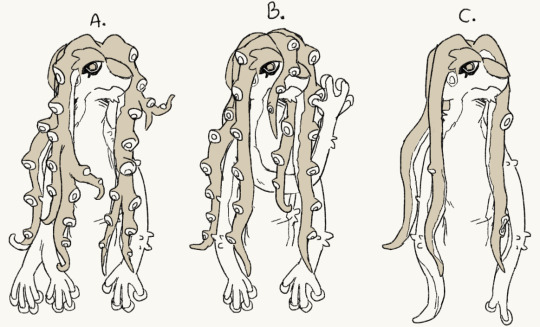
[Three common limb mutations, the most common types of significant mutation among cephalings. Limb mutations can occur as part of a genetic condition or by chance during regeneration of a limb. With the modern prevalence of tentacle cutting, it is said that up to 40% of limb regenerations involve some form of mutation. Pictured are A. branching, B. anemonism and C. blanking.]
White Beak. The color of the inkfish beak especially varies greatly in its ratio of black and white. While the base of the beak is always pale, ancestral squid and octopus beaks were mostly dark in the exposed area. In modern inkfish, a common mutation makes the beaks almost entirely pale, which also has the effect of them being softer in comparison. In the current day, predominantly white beaks are more common than black beaks are, although the majority of people will have some form of gradient in beak color and hardness. In a big part of the population, this comes with a larger risk factor for beak chipping and limitations for food hardness, though it also reduces the risk of beak overgrowth in comparison to black beaks. Brittle beaks are usually treated primarily with a threshold for maximum food hardness and beak polish to protect the surface of the beak, whereas beak chipping is usually handled by attaching artificial parts to the beak to shield it during regrowth or filing the rest of the beak to be level with the chipped segment. Cracks in a beak can be filled in with a hardening filler substance that conceals the crack and strengthens the beak.
Color Lock. Some cephalings are born without some of their ink sac chemicals, which limits the colors of ink they can mix - some extreme cases are limited to just one color. Aside from the inconvenience of having limited ink colors, the mutation is harmless. In some cases, people may choose to treat color lock by ingesting dyes to color their ink to whatever the situation calls for. Sometimes, color lock can be caused temporarily by a disease or underlying health condition, but permanent color lock is only genetic.
Ink Wither. A condition in which the ink sac produces very little ink, and may stop producing ink completely. It causes permanent ink drought, though ink drought on its own is usually a temporary symptom caused by a myriad of things. Although ink wither usually exists from birth due to unusual development of the ink sac or other related complications, it is sometimes caused when an ink drought caused by other triggers, such as disease, dehydration, bacterial infections or malnutrition, is prolonged and becomes chronic. It is treated mostly through artificial ink refills, ink soak therapy* and external mobility aids due to low ink levels often causing complications with stability.
(*Ink soak therapy is a treatment in which an inkfish bathes in a shallow tub or dish of ink. Prolonged contact with large amounts of ink has been proven to stimulate the body's own ink production, so it is an effective remedy for some instances of ink drought and also helps absorb ink into the system.)
Ink Boom. An opposing condition to ink wither in which the ink sac produces excessive amounts of ink and continues to do so even when full. It usually co-occurs with chronic ink bleed. The severity of the condition determines difficulty of the treatment; in cases of slightly above-average ink production, attention to hydration and sufficient purging of ink throughout the day may be enough to manage the condition, whereas high-producing cases may require constant monitoring and frequent hospital stays. In most affected people, the severity of the condition varies on environmental or other factors and may come in episodes. Ink boom is a condition often developed by long-term ink battlers due to frequent usage of large amounts of ink, but may develop throughout childhood or in adulthood, where it most often develops from substance use or stress. Typical symptoms include comorbid chronic ink bleed, stiffness, swelling under the skin, dehydration, malnutrition and restlessness. Treatments include purging of excess ink to avoid buildup, monitoring hydration and nutrition levels, medications to relax the ink sac or, in extreme cases, removal of the ink sac, which imposes dependence on externally sourced ink but eliminates the root cause. Ink boom sometimes occurs temporarily as a comorbidity to various health complications, and is sometimes a precursor for progressing into ink wither later in life.
Branching. Branching is a state where the limbs split and branch at the ends to form new ones continuously. Branching can be developed at birth, upon which it is typically permanent. A person with branching will typically have their limbs split into two or more growths upon the tip being cut off, or a new branch may start growing out of a non-injured limb arbitrarily. It can affect all the limbs or just some of the limbs, but an inkfish with genetic branching will always develop branches on a limb, even if cut off and regrown, although the size and position of the branching may change and vary. In individuals where only some limbs are affected, cutting off an unaffected limb will typically spread branching to that limb upon regrowth. Consequently, there are many people that are unaware of having the condition due to having no external traits until a limb is first regenerated. Some people may develop temporary branching as a result of stress, or randomly while regenerating a limb. Branches can be removed by cutting off branches and burning the root tissue to prevent regeneration, although this is done primarily for cosmetic reasons due to branching of the limbs being generally inconsequential health-wise.
Anemonism. A common genetic mutation that causes more than the usual amount of limbs to form. In most cases, it manifests in the form of additional crown tentacles, but there are sometimes extra arms or legs. The rarity goes up with the amount of extra limbs present; it is quite common for inkfish to have one or two extra crown tentacles, for example. It differs from branching in that the new limbs originate straight from the body with complete or partially complete muscle groups, rather than branching off from an existing limb. New limbs do not grow in later in life, although the onset depends on the type of anemonism; additional locomotive limbs are present from birth, whereas additional crown tentacles will grow in with the rest of the tentacle crown. Conditions where one or more of the limbs or crown tentacles are absent are considered a subset of anemonism, usually referred to as reverse anemonism.
Blanking. A somewhat rare condition which causes less or no suction cups to form, resulting in greatly reduced amounts of suckers and a signature “blank tentacles” look. It is usually present from birth, although similar effects may occur in regenerated limbs for people without the condition. It affects both the crown tentacles and the graspers; some people may only have a few suckers, some people may have none at all, and it may affect different limbs disproportionately or only affect some of the limbs. It is most noticeable in octolings, although it occurs in all sucker-bearing cephalings. In decapods, it often causes the tentacular clubs to form in unusual shapes or not form at all, and commonly results in oddly shaped or missing sucker rings. People with the condition often have comorbidities affecting the suckers, such as splitting, asymmetry, stunted development of the sucker or dulled chemoreception. For people with blanking, cutting off and regenerating limbs still produces reduced suction cup numbers, and developing other regenerative limb abnormalities is quite common. It is a condition that doesn’t require medical treatment, although people for whom it affects the graspers may benefit from specialized equipment for fingerless species.
General Limb Abnormalities. Extra limbs, missing limbs, extra suckers or missing suckers, limbs with no hand or multiple hands per limb - the list goes on. There is a plethora of limb abnormalities within neocephalopods, and they are not actually that uncommon; roughly one in 5 inkfish has something of the sort at some point of their life. Oftentimes, extra limbs, suckers or arms are at least partially or even fully functional. Many limb abnormalities are permanent and present from birth, while the most common ones can develop at any time, usually resulting from damage to a limb. People with one type of genetic limb abnormality are also likely to have other coexisting conditions; for example, anemonism and blanking often co-occur.
Kraken Syndrome. Kraken Syndrome is a psychological condition where the Kraken response* triggers dangerously easily. This condition occurs when the body is conditioned to frequent Kraken transformations to the point where the brain becomes exponentially more receptive to triggers for Krakening and thus dramatically lowers the threshold for natural Kraken episodes to occur. When this threshold is low enough, the Kraken is triggered abnormally easily and Kraken Syndrome is diagnosed. It is treated mainly with exposure therapy, mood stabilizing medication, depressants and sedatives, and specific medications that induce fatigue or physically weaken the body enough to prevent physical Krakening. It is highly comorbid with anxiety disorders, which also often function as triggers. Kraken Syndrome became widely documented in the late 2010’s, almost uniquely among frequent users of the Kraken special weapon. It is not to be confused with the rare condition where the Kraken form is able to be triggered at will with no psychological effects; this is not a type of Kraken Syndrome as it involves a voluntary transformation as opposed to a lowered threshold for involuntary uncontrolled transformations.
(* The Kraken response occurs with the fight-of-flight response of inkfish and correlates with a threshold of emotional distress that triggers the transformation. During a Kraken transformation, the inkfish becomes aggressive and disoriented, ink production is drastically increased, ink builds in the muscles and tissues increasing the individual's size, and a deimatic display is forced, often creating a high-contrast pattern. It isn't a panic reaction in itself and not all panic reactions inherently lead to a Kraken episode, but some degree of extremely high anxiety and desperation or anger are mandatory for a Kraken to trigger. The threshold that a Kraken triggers tends to vary based on person, but it generally requires an extremely high-stress situation with imminent threat. In general circumstances, the average inkfish will probably Kraken zero to three times in their life.)

[An image detailing the differences between typical emotional agitation required to trigger the Kraken response between unaffected individuals and those with Kraken syndrome. The special charge state is considered the basic state of agitation when special weapons become usable due to increased metabolic rates and high ink production. The Kraken response is typically far above the average person's typical agitation levels and triggers only in extremely dire situations. Usage of the Kraken drug for Turf Wars artificially lowers that threshold for the transformation itself to roughly the same threshold as the special charge state. Frequent transformations under the influence of the drug do not trigger the psychological disorientation and other effects of the Kraken, but they are still generally detected by the body and brain as an emergency situation, which lowers the natural threshold for natural Krakening over a long period of transformations to compensate for frequent threats. This causes an effect where even minor agitation may trigger the brain into a full-blown Kraken transformation in response to a nonexistent threat and is the case for people with Kraken syndrome. High-strung Kraken syndrome is diagnosed when the threshold for Krakening is so low that it co-occurs with the natural special charge state of the individual or even before that emotional threshold.]
Deep-Sea Gigantism. Shortened often to DSG, deep-sea gigantism is a sudden growth spurt caused by high long-term stress levels. It is a defensive response to unfamiliar or threatening life situations, mostly fueled by hormonal changes in the body in the long term. DSG gets its common name due to its prevalence in people moving in or out of the Deepsea, in which case it is often triggered by extreme change in pressure levels, disorientation through change in environment and general stress of moving, which captures a lot of common triggers for the condition. The name isn’t to say that the underground or -water are the only conditions where it occurs; it may occur as a response to any type of long-term stress, anxiety, frequent threatening situations or even some medications. The main symptom of deep-sea gigantism is unnatural, accelerated growth that might be dismissed in the short term and only becomes apparent within the span of months where it becomes clear that the pace is abnormal, and it is common to outgrow the typical size estimates for one’s species under long-term DSG. Other symptoms include increased hunger and appetite, fatigue, rapid muscle gain, headaches and general disorientation. The condition may be self-fueling due to the body directing most of the energy into growth and thus causing potential deficiencies elsewhere. Long-term instances of DSG with significant growth may also cause issues and comorbid conditions to develop due to the growth of the body and the growth of the organs and ink sac often being disproportionate. Deep-sea gigantism differs from regular gigantism in that it is a temporary (albeit often long-lasting) condition that has external triggers as opposed to a permanent condition. It is typically treated with anti-stress medication, eliminating underlying root causes, and limiting energy intake. Short periods of DSG often go entirely unnoticed, but longer periods are highly problematic due to the increase in body size not being reversible.
Hyperchromatophorism. Casually referred to as hi-chrom, it is a type of hyperpigmentation that causes chromatophore amounts in excess and causes the skin to be abnormally brightly colored in adult individuals where chromatophores are typically sparse. It is different from late onset of mature chromatophore sparsening due to the density of chromatophores being drastically higher to begin with. Usually, hyperchromatophorism is present from birth and affects either the whole body or large areas of the body, causing vivid colors and patterns to display across the whole body or areas of the body rather than just the crown tentacles. The intensity of these colors depends on the individual, and the condition may be light and only cause slightly increased saturation in parts of the body, or it can cause the entire body to be a solid color. It is mirrored by hypochromatophorism, which is a partial or complete lack of chromatophores in an area, and is about as common as the former but less noticeable due to mainly being visible in the crown tentacles. Either condition can occur in people without the conditions in areas where skin regenerates, and is quite common with large wounds.
Chronic Ink Bleed. Chronic ink bleed is a condition where excessive amounts of ink seep through the skin and the ink ducts are permanently, or predominantly, open. It is a consistently repeating or constant presence of the ink bleed condition which varies in severity based on whether the ink ducts are permanently open or only frequently open. Chronic ink bleed almost always co-occurs with chronic dehydration, low ink levels, malfunctions of the ink sac and ink system and mobility issues stemming from ink loss. It is usually managed with means that prevent or lessen ink evaporation; absorbent body wear, lotions that clog ink ducts around the skin or other medications that force the ink ducts to close, or alternatively frequent ink refills often administered by portable machines intravenously. Inkfish with chronic ink bleed often fare poorly in areas with dry air. Significant and long-lasting ink bleed is often a symptom of illness, and it may turn chronic after severe episodes of sickness. Chronic ink bleed can be a birth condition or it may develop later in life; late onset is often seen in professional Turf War players. It may also develop as a side effect of medication, unrelated illness, high stress or anxiety levels or hormonal imbalance, although in these cases it is typically reversible.
Color dysfunction. Color dysfunction is a condition where the color-changing skin cells aren’t under conscious control, and cycle colors randomly. It doesn’t apply to dead or inactive chromatophores as the affected cells are alive and active, but the ability to control them is absent, limited, or leads to inaccurate displays. Cephalings with the condition have highly variable skin patterns, from constantly cycling colors in no particular order, spontaneous deactivation or activation of the skin cells, or colors that somewhat correlate with emotion or activity but still have no conscious control. People with color dysfunction may have it across the entire skin, or it may be isolated to specific patches of the body while other areas have controllable pigment cells. It may also develop in areas where skin regenerates for people that do not have it as a pre-existing condition. It is most often present from birth, but sometimes develops later in life in response to stress, brain damage or psychological conditions, where it may be permanent or subside with time. Symptoms also often arise temporarily as a response to drugs, medications or high stress situations. Color dysfunction has a high occurrence rate alongside different psychological conditions and is presumed to be a mismatch of electrical signals in the brain to what is actually displayed on the skin, or overall dysfunction of the center that dictates color change.
Color stasis. Color stasis is a subtype of color dysfunction where the color-changing cells are alive but permanently deactivated involuntarily. It differs from chromatophore atrophy or chromatophore death in that cells are not dead, but deactivated. It is caused by inactivity of the brain center in charge of color change, whether that is due to an absence, partial inactivity or nerve damage to parts of the body or brain. It can be present from birth or develop later, typically due to brain damage or substance abuse. It may also extend to all skin or only be present in select areas or patches of skin. People without the pre-existing condition sometimes develop individual patches of color stasis in areas where skin regenerates.
214 notes
·
View notes
Text
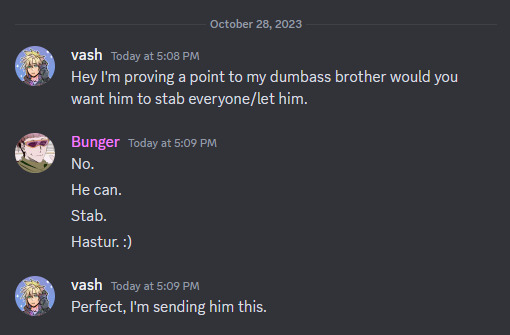
@knifesnuggie
I texted Howie.
3 notes
·
View notes
Text
...
🥴
I promise. I will.
Be.
Gentle.
7 notes
·
View notes
Text
Tagged by @capitano-marina
Rules: Shuffle your 'on repeat' playlist and post the 10 first tracks, then tag 10 friends to do the same.
1. Love Somebody by Morgan Wallen
2. Drinkin' Problem by Midland
3. Deeper Than the Holler by Randy Travis
4. Freight Train by Aaron Watson
5. Where I Find God by Larry Fleet
6. Tennessee Orange by Megan Maroney
7. With Love From by Aly and AJ
8. Letters From Home by John Michael Montgomery
9. Greatest Love Story by LANCO
10. I'm From the Country by Tracy Byrd
Tagging: @gravityalex @stars-in-our-oceans @the-ominous-owl @wraithofwords @whatwordsmiss @whatimdoing-here @korralone @bi-halobearer @bechloesupercorp @squidthoughts
2 notes
·
View notes
Text
it IS genuinely nice that neutral pronouns are used for capt 3, like hey i feel seen and that’s cool!!!, but it’s in the manner of “leaving things open so you can use these or use your own pronouns”.
the notes on that post really got it right. splatoon’s agent characters aren’t like chara or frisk from undertale, or kris from deltarune, where these three characters are all very much defined as their own person with specific pronouns. the agents are meant to be “blank slates with some degree of flavor”, we’re meant to fill in the gaps. 8′s an anomaly due to having a lot of characterization in writing but there’s still a lot of free space for personalization and headcanons.
context is very important for neutral pronoun use, like using they/them for people you don’t know the correct words for. similarly, UT+DR and splatoon aren’t using these pronouns the same!
#squidthoughts#there. thats my new textpost tag#anyways yeah it's been bouncing in my head and that post did it right.
6 notes
·
View notes
Text
Inkling Biology 201
Okay, so I decided to try and nail down what the fuck is actually happening with my Inklings. I’m not super great at describing or explaining, and this shit is DEFINITELY not gonna be 100% true to real world science.
Alright. So before I dive heavy into whatever the fuck Inklings do, let’s set a basic idea. While I don’t totally agree with lesbian-octoling on how Inklings work, I do agree that the basic idea is sound. Basically this diagram, with ink bones and shit. That bit is sound. Anything after that, I have my own opinions on since I like Weird Campy Scifi Nonsense. Be warned, very little of this will make any true scientific sense.
Okay. So, let’s start with the Important Shit. Three hearts, an Ink Sac, lungs, stomache, intestines, all that useful stuff. It’s supported by a semi-cage semi-pouch made of cartilage, which helps the body keep a torso shape instead of collapsing into a pile of boneless ink. The cartilage and organs are protected by a sort of skin layer as a protective measure, sort of like blubber. Then you’ve got their blood and muscle and skin layer. Whenever Inklings shift between Squid and Kid, they automatically drag most of this into their personal Ink Dimensional Mass, leaving them as sort of just a moving head. It’s weird.
The Ink Sac deserves more focus, though. The thing is hardy. It pumps ink out all day every day, and it’s honestly the hardest working organ in the body. It generates two types of ink - the ‘Bone Ink’ that gives the illusion of being a creature with a skeleton, and the ‘Combat Ink’ which is more refined and is ready for use outside the body. Losing Combat Ink isn’t a big deal - if that stuff stops coming, fine. You can still live. Losing the Bone Ink, though? That’s a sign you’re getting old, and it’s usually when an Inkling starts their sundrying phase.
Combat Ink, by the way, isn’t emitted through the gills. Once Inklings evolved to basically Not Like Water, gills became useless. These days, you can rub them together in a way that emits a certain frequency to lock onto and Superjump towards. It’s got something to do with magnetic frequencies or some such. Making a loud noise with it is also an intimidation tactic - the Inkling equivalent of cracking your knuckles.
Combat Ink actually comes out of that coloured tentacle bit on their head. Y’know that Inkling boy buzzcut? Well, minus the scars, that’s actually what an Inkling’s head normally looks like. Ink is naturally pumped out of that patch of headskin, where back before they were fully evolved, an Inkling could grab some with their hands and fling it to blind foes - though that isn’t really needed these days. It kind of has a syrupy feel to it, where it’s goopy and weird. Inklings and Octolings can also control this ink, to an extent - bits of ink eating bacteria moving, shaping and freezing it according to rapidly flashing bioluminescenesense on the Inkling’s neck. I don’t know how to spell that word.
Tentacles are... Weird. See, the Ink Sac goes hard all the time - it has no way of knowing if it’s made enough ink for you to live - all it knows is how to produce. Tentacles serve as a sort of immune system for this thing, gathering up loose ink and any dead cells, and growing it out on the head so that an Inkling doesn’t. Y’know. Explode. Having overly large tentacles isn’t really a problem, it’s when they grow out to huge sizes overnight that it becomes an issue. Usually a sign of chemical imbalances or something.
Inklings are crazy porous - they can move through most grating and poles in their Squid form without much worry. However, this porous nature is why Inklings are their own worst enemy - they absorb liquids like a sponge, especially ink. This is a problem, since any ink they absorb fills up their body. Most Inklings carry around 70% ink at any given time. In combat, they can hold up to 100%. Try to go past that? They’ll explode like a water balloon and wind up back at the Spawnpoint. As such, most Inklings are terrified of large bodies of water, even if they can come back from the dead. This has led to several REALLY FUCKED UP horror movies about drowning, and force feeding and rainbathing. It’s gross.
Octolings have a few different features to Inklings. For one, their masks? Unneeded these days. They haven’t lived on the Surface, and haven’t been exposed to enough light to need them. They also have claws, hardened skin to grip onto things and harm enemies easier. As they get older, they also have stripes appear near the back of their neck, near the gills. Naturally born Octarians have their entire eye turn green as they get older, and they get ‘Painted Claws’ - a symptom of age where their claws permanently settle on the colour they use the most. Octarians born in the cloning Vats are born with Painted Claws, and those never settle on any colour.
Most Inklings and Octolings, barring disease or illness, live up to 200 years old. They usually remain fit and healthy for about 150 years, start slowing down somewhere between their 150s and 170s, and start sundrying themselves for the remaining 30 years. Sundrying is basically reducing your body down to a state of pure survival - no colour, no Shifting, no nothing. It’s considered really creepy.
That’s about it... I can’t think of anything else major.
13 notes
·
View notes
Text
OKAY SO. He's not really an official therapist but that's okay because I do not think official therapists actually exist anymore outside of the Six Cities and like Ship 3 and I don't think a normal therapist would know what to fuckin' do with me anyway aside from maybe go "hey you know what would be great, being set for LIFE" and. Uh.
The point is that I know some folks and one of those people is Howie (@squidthought) and he's an Elder One and he's kinda my therapist now and it's nice to have someone omnipotent to tell me things.
...okay I have to be honest with you I phrased it that way specifically to make you go "WHAT? HUH?"
your fuckin. huh. sorry. your who
4 notes
·
View notes
Text
It feels like everyone I follow/follow me are following each other. idk
0 notes
Text

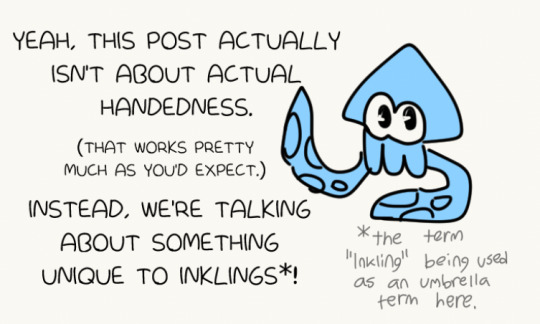
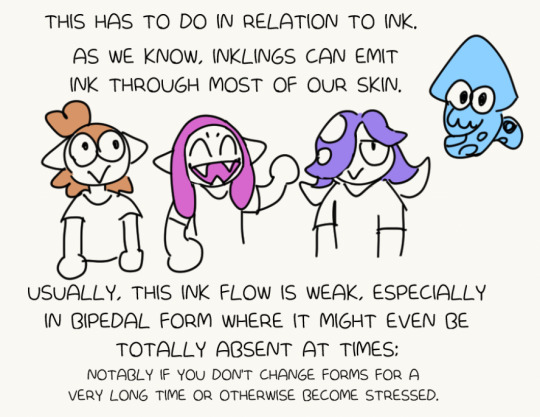
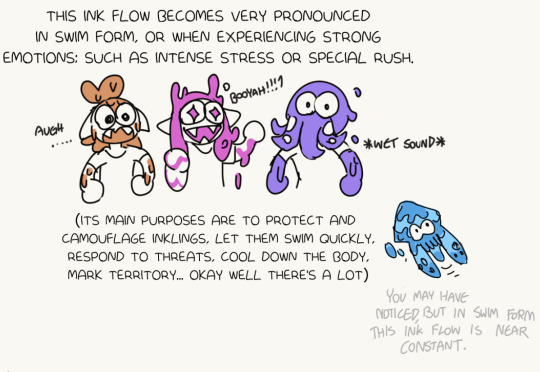
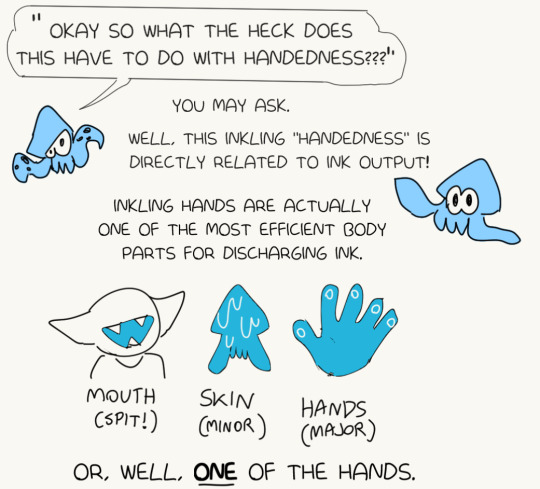
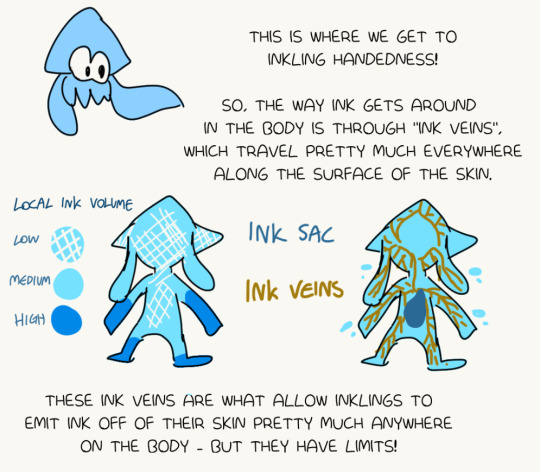
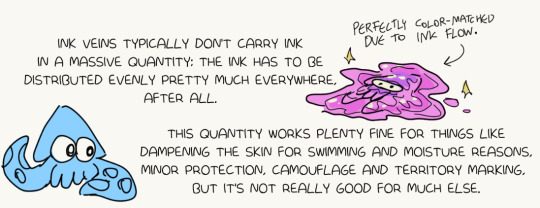
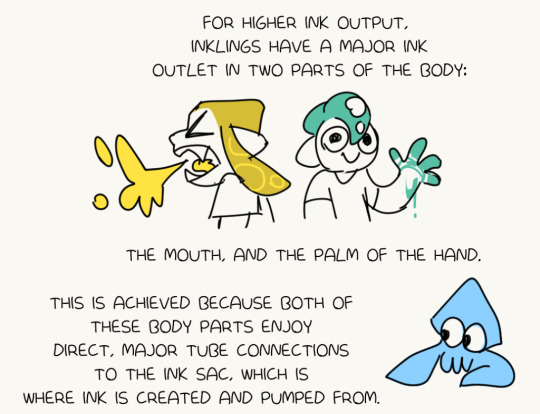
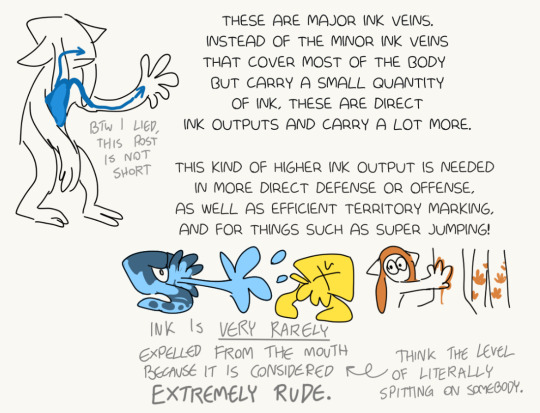
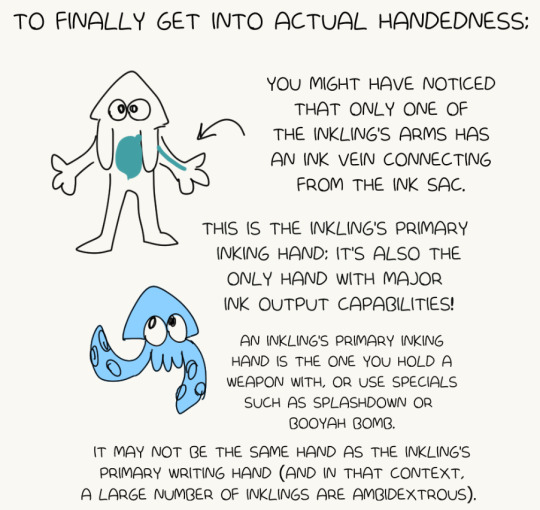
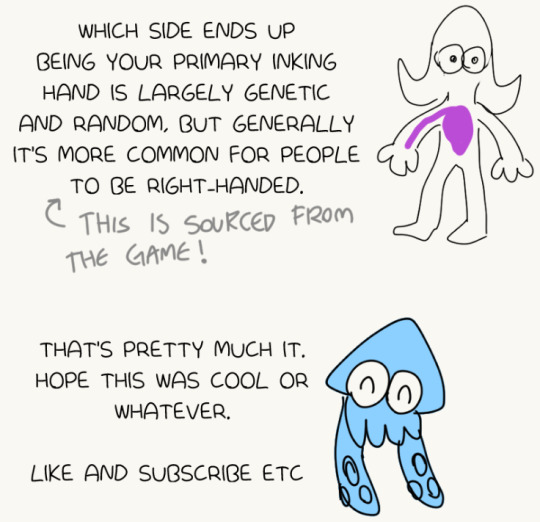
"Short Post" on something that spawned in my brain this week while pondering ink tanks, and the concept that Inklings fill their weapons directly from their hand to the weapon handles.
Also based on that one sunken scroll that shows the Inkling's internal ink sac anatomy and a tube from the sac going to... their shoulder. (This is stupid and pointless and I've decided it either goes into the arm or the mouth or both and I think the arm makes sense)
The only weapon this really falls apart with are the dualies, which use both hands, but the dualies also have very small ink tanks so their requirements for ink might be met by just the natural increased ink flow on the skin (which I think would generally be stronger on the limbs).
Note that this could work totally well with both arms working like this; I just kept it to one arm only to mirror human handedness, the way Inklings seem to favor one hand in the game, the sunken scroll showing the ink sac tube primarily going to one side, and cephalopods really only having a siphon on one side (despite people often thinking they have two! They can move it; octopuses, specifically.)
Sources for this: - Specials, notably Splashdown and Booyah Bomb emitting ink from the palm of the hand as the main gimmick - NO tube between ink tank and weapons - like a 5-hour discord DM with @rassicas about how ink tanks make zero sense while i was also supposed to be paying attention at the mall - Like every ink-using creature in Splatoon EXCEPT INKLINGS fires ink from their mouth - Most weapons are held in the Inkling's right hand (shooters, largely) - Both Splashdown and Booyah Bomb use the right hand as well - my 1 brain cell - the sunken scroll showing the ink sac anatomy of the inkling pretending it goes to the arm instead of stopping at the shoulder
Also don't like and subscribe because i dont have youtube.
2K notes
·
View notes
Note
How would inkfish take care of their “hair”? If at all
Yes
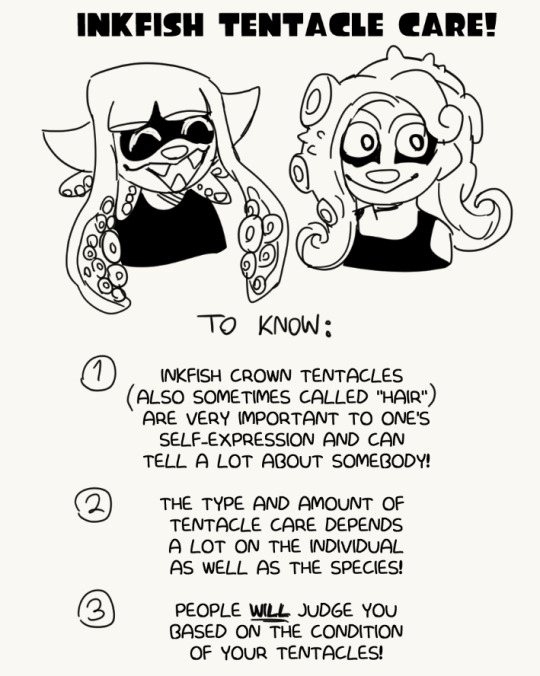
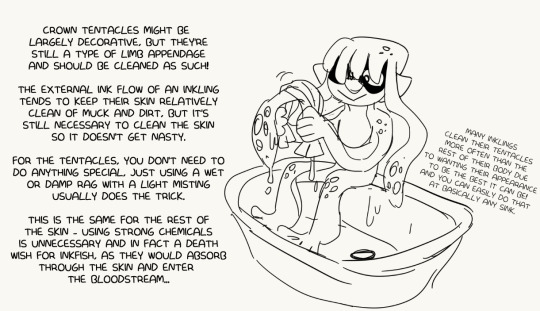
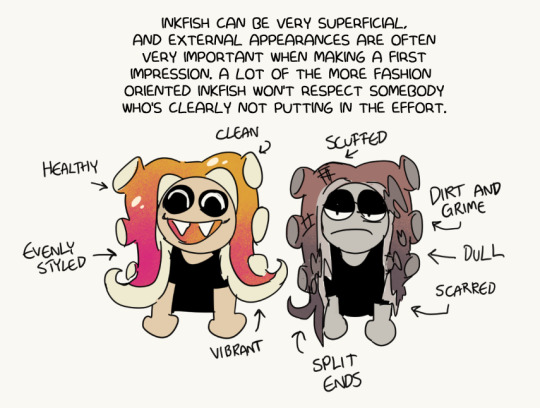
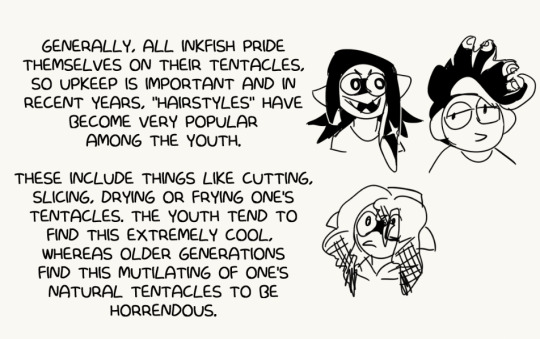
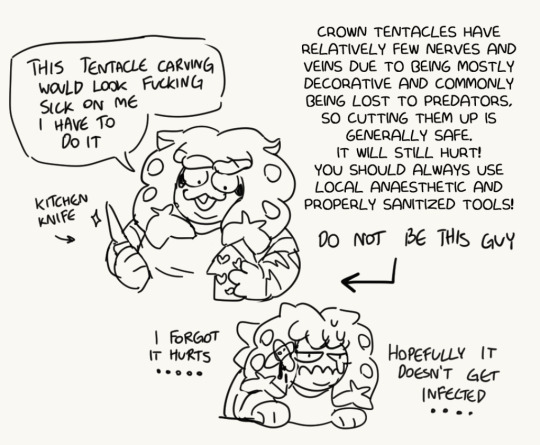
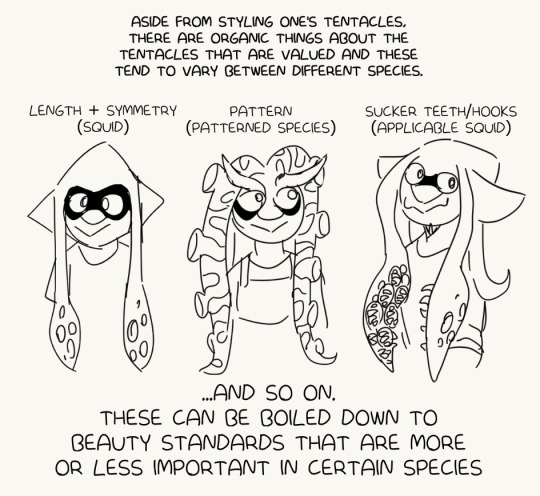
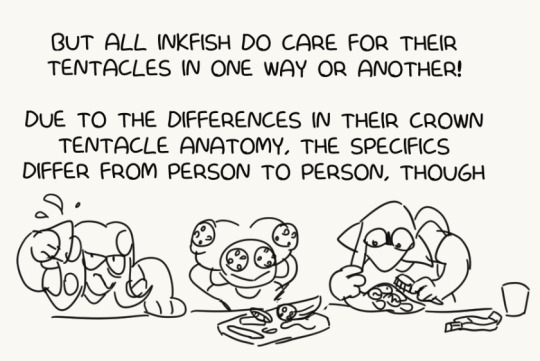
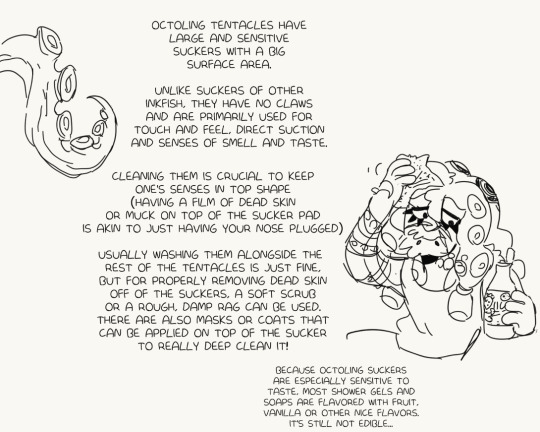
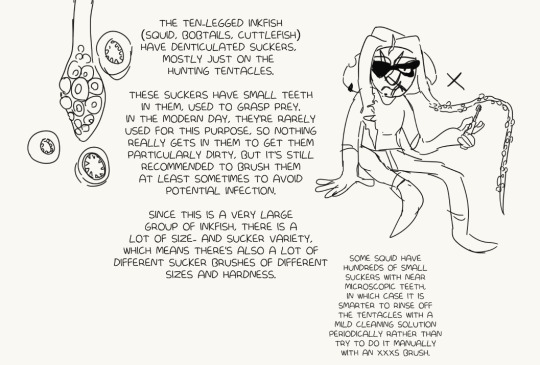
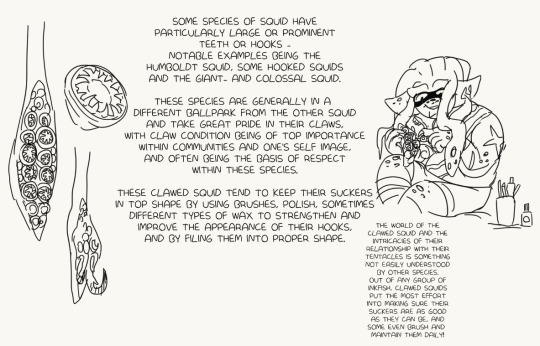
My tedtalk. Thanks for asking! (Sorry it took forever lol)
1K notes
·
View notes
Text

RE: Question about whether the Deepsea and the Octarian Domes are directly connected to each other. sorry i'm stealing your reply @bucketsquid but i see a chance to talk about this i have to take it. So idk let's try to decode how they might actually be connected.
This is the obvious conclusion. For the record I think it's the RIGHT conclusion after Side Order because they seemed to REALLY imply it this time. I thought for a really long time that the Deepsea and Octarian domes HAVE TO be connected because not only are they both subterranean but also literally how else do you get that many freaking Octolings in there? Since the metro is connected to the Inkopolis subway anyway wouldn't it be WAY EASIER TO JUST GET SQUIDS? (though to be honest i still stand by this.)
Anyway the obvious assumption is that the Deepsea and Octarian domes connect to each other. though it's not so straightforward. How they connect to each other exactly? we don't really know. Anyway let's get back into this in just a second i need to show what absolutely dashed my hopes and made me really mad when it happened
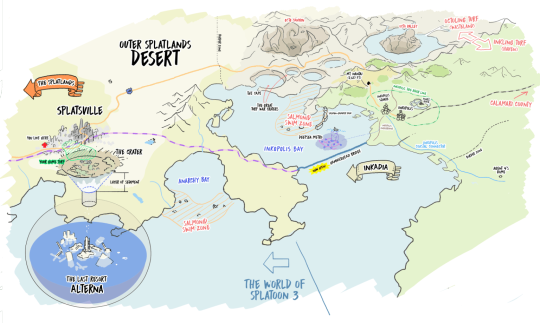
THIS MAP. THEY POSTED THIS MAP. Before this map I was having a great time because this is what the map was in my head:
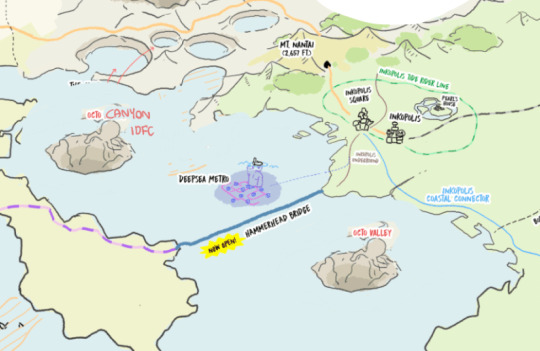
"why was that the map in your head" idk. the giant stretches of water surrounding both canyons and inkopolis stretching into said body of water gave me the mental image that the canyons were in the ocean by inkopolis' coast. alongside some of the very old concept art that shows some of the domes even being underneath inkopolis if i'm not mistaken!
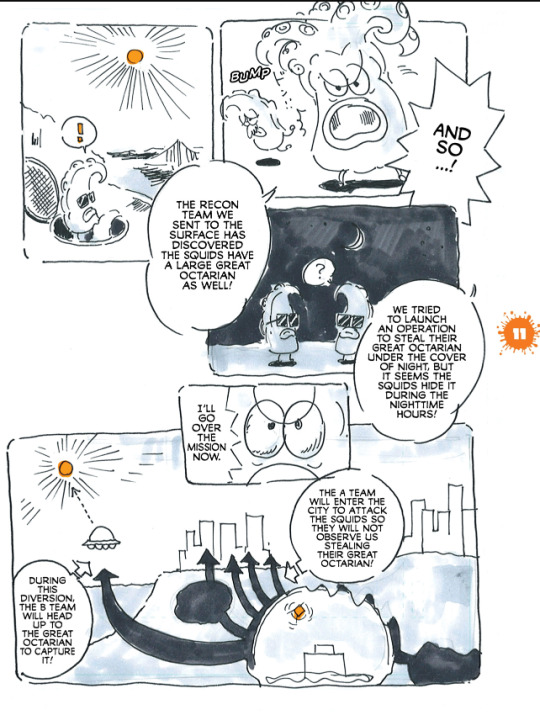
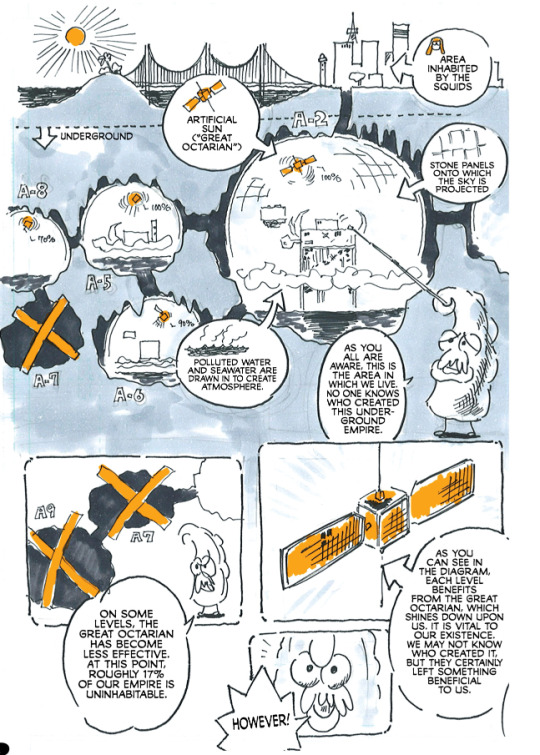
from the art of splatoon 1. this is an ancient and I MEAN ANCIENT manga depicting what is obviously an early concept of the story so it shouldn't ACTUALLY be taken as fact (almost nothing in this manga holds up anymore). But some of the things WERE kept! I have to assume this is also why you get into Octo Valley through the sewer in the games because the story mode was meant to take place literally straight underneath Inkopolis... it makes a lot less sense in the final result when you supposedly take the sewer like 50 kilometers (i dont know the actual distances but i think they're able to be deciphered) underground to a canyon in the middle of nowhere.
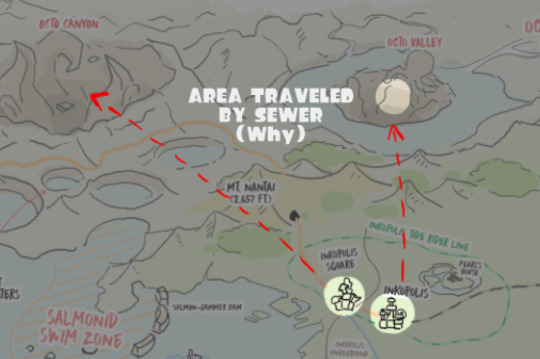
Why is there even continuous sewage all that way. What is happening. Is it even a sewer or a really long underground secret tunnel that Captain Cuttlefish dug because he's been really bored for 100 years.
kind of besides the point. back to the issue of the deepsea and the octarian empire being connected. You know, with the Deepsea Metro being located in Inkopolis Bay and the domes supposedly being all over the Inkopolis underground and the surrounding locations, it didn't seem that far fetched that they could siphon Octolings from the underground (where they live) to another very close-by fork of the underground (the Deepsea). However,
1. the Deepsea is NOT Octarian territory, but its own type of society. which is really weird considering how much Octarian iconography is down there, let alone how many OCTARIANS are down there
2. We have SO LITTLE knowledge about the true scope of the Deepsea that you can't even say for sure whether the Deepsea is *JUST* the Deepsea Metro and the facilities and industrial cities in that exact specific area, or if it's a big underwater and underground empire similar in scope to the Octarian domes, maybe even built in the exact same dome network - or a neighboring one. (This would mean they have a border somewhere undefined, underground.)
3. At face value with only the map, this is the distance for a Single Octarian to travel in order to get from where they live/are stationed, to get to the Deepsea Metro which is cluttered with one billion octarians
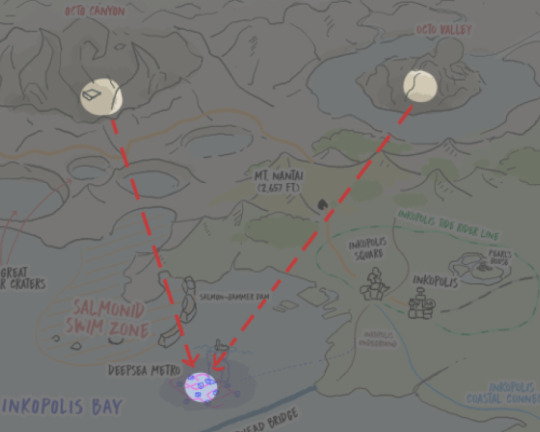
HELLO? THAT IS SO FAR. it's even worse than the distance Agents 3 and 4 are swimming through the god damn sewer. This also makes very little sense if we assume all the subterranean domes in all of these locations are exclusively under their surface counterparts... which... well, we don't know.
We know that the Deepsea Metro is connected to the Inkopolis Underground (it even shows this on the map with the little dotted line). I don't really know the significance of that but I've taken it to mean that the Deepsea Metro that is highlighted in the map shows specifically the area covered by the Kamabo Corporation and the tests there, and honestly again, I don't even know if the Deepsea is any bigger than that. Since it's been stated to be an independent society from Inkopolis or the Octarians, you would ASSUME there'd be ample space for people to like, live, and maybe work, and produce stuff you need to like, live. Instead of the test facility being literally the only place that exists plus a city built around only that to sustain everything.
Furthermore, we don't know if Octarians have cities on the surface in their part of the surface world! This is something that really bothers me because I think knowing whether or not this is the case would change SO MUCH (i'm currently under the assumption it is a barren wasteland with Literally Nothing). However given the location of the Salmonid Swim Zone, we can SEE cities in the background of multiple stages, and judging by this map those would be mainly on the Octarian coasts. This could mean that Octarians have surface cities where they coexist with the Salmon, it could mean that they USED TO have surface cities and abandoned them, OR it could mean that Salmonids actually live on Octarian surface turf while the Octarians themselves live underground! Idk! There's a lot of options!
I kind of doubt Octarians have cities on the surface because if they did, then it would feel redundant for the game to keep coming back to "the Octoling world" being this horrible military regime underground that people try to get to the surface from. If it was that easy to get to the surface it feels odd that it would be a big deal. We know that the Octarian domes, at least in Octo Valley, are specifically an underground *secret* military base.
(*Secret* being explicitly stated before and it would imply that they wouldn't necessarily NEED to live underground, but it's just way easier to do Secret Things underground. Plus the surface is a wasteland so honestly not a lot to lose there.)
We still haven't really seen what they have aside from that. We don't know where they get their food, for example. There's got to be farmers in a society. There HAS TO be some kind of surface access or activity, and if you squint, Octo Canyon IS a surface city that they seem to have free access to. So why not have others? It seems only logical to have more. In this case the oppression of the Octoling world and being forced to stay underground feels really case-specific, but it seems to also be an overarching thing that's quite widespread, so... I don't know, I WANT MORE OCTARIAN WORLDBUILDING *PLEASE* i'm working with crumbs here.
Anyway. my current assumption of the subterranean areas of the Deepsea and the Octarian empire goes something like this, all things considered that I've talked about...

(Not exactly that but you get the general picture)
When you put it this way, it suddenly makes a lot more sense that Octarians would be getting into the Deepsea. Generally I tried to keep the locations of Octarian tunnel systems to their turf, and the locations of Deepsea tunnels under the ocean floor, though with Octarian domes explicitly stated to have been dug by humans there's. really no reason they couldn't stretch into Inkling territory. We have no idea how big these tunnel systems are in scope, NO idea.
And that's also the problem with trying to solve this part of worldbuilding, because my concept could easily be right but it could also be COMPLETELY wrong! It's totally possible that the dome networks are actually secluded and tiny and are *just* under the Octarian craters and nowhere else, and it's totally possible that the entirety of the Deepsea is JUST Kamabo Co and the few settlements surrounding it. I'm not that confident that I'm right but I'm not really confident that we'll get answers to these questions either, at least as long as the story modes keep intentionally avoiding expanding on existing game locations and pretending theyre not in the splatoon world at all by making their key locations abstract and closed off bubbles on purpoCOUGH HACK who said that
There is 1 thing I've completely failed to mention in this post and it's that Octo Valley and the Deepsea Metro are like, explicitly connected. Which by the way makes NO SENSE given they're on opposite corners of the map. But between what we know from Side Order and from this Official Snippet from Splatoon Base, the Official Splatoon Story Resource By Nintendo,

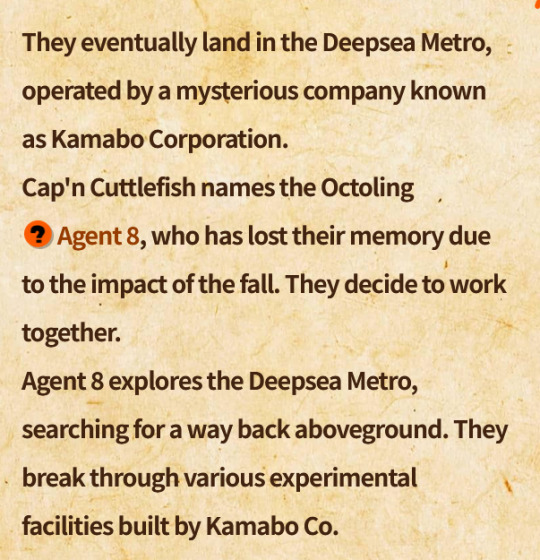
Ignoring that none of this makes sense anymore or is intentionally misleading compared to what we know from Agent 8's memory loss now. Anyway. This seems to just imply the Deepsea is *under* Octo Valley. WHICH WOULD LINE UP WITH SIDE ORDER, weirdly enough. It is possible that the Deepsea domes could actually OVERLAP with Octarian Domes, it's just built FAR under sea level, not bound to the actual location of the sea itself.
I want to point out that this segment in the splatoon base and the game itself and dev interviews all tend to contradict each other in some ways when you look at them side by side, which is frustrating, but also serves as a reminder that sometimes the official resources don't know exactly what they're talking about either. so it's often not worthwhile looking them up and trying to conclude something based on it just to find out that it's literally contradicted in the game itself.
anyway, we know One Thing now and it's that there's at least no way that Octarian domes and the Deepsea AREN'T connected to each other in some way. this post doesn't exactly solve the issue of How but there was an attempt. I don't think this is ultimately something you can come to a concrete foolproof conclusion on until there is more information. But in the meantime I guess there's speculation.
300 notes
·
View notes
Text
Biology of Inkfish - Lifespan
Most cephalings have lifespans in the mid-to-late 60's - a formidable age for a cephalopod. This comes with some variation; larger species typically have longer lifespans and commonly reach ages of 80 years to even a hundred, whereas small species tend to live shorter lives of 40 to 60 years. This pattern of lifespan variety matches with larger species also maturing slower than small species, as some large species do not achieve "Turf War age" until 18 or 19 years old, whereas small species may do so as young as 9. In the modern day, modern medicine and special procedures, such as sun drying, mean that inkfish in particular lead long lives, with common-sized species routinely pushing 100 years in age.
Unlike some animals, cephalings do not stop growing after their initial growth spurt during puberty. While their growth slows down to a crawl, cephalings will continue growing for the majority of their adult life at a slower rate mostly dictated by environment, diet and species. This growth tends to average around at 1-2cm per year, with smaller species growing less and larger species growing much more. In inkfish, this growth will slow down towards their 50’s, after which lessened ink production and ink retention rates will make them shrink over time.

[The life cycles of a squid inkfish illustrated from paralarval juvenile forms (1-5) to teenager (6), adult (7) and elder (8). In elderly inkfish, the ink sac and ink production dry up and chromatophores dull out. Muscle loss often causes tentacle crown collapse, leading to the tentacle crown to cover the face at all times.]
Juvenile Inkfish
All inkfish start their lives as paralarvae. Hatchlings are tiny, 4-limbed critters with well-developed eyes and not-so-well developed locomotion skills. The paralarvae develop inside their eggs until they are large enough to poke out of the egg head-first. Newly hatched inkfish are helpless and depend on their caretakers, typically the mother, to protect them and bring them food. Oftentimes a mother inkfish will carry its offspring around on its crown tentacles*. Newborn inkfish have a natural instinct to grip onto things with their tentacles and mirror the color of those around it. Young inkfish are a solid color to help them better camouflage into ink; the chromatophores in juveniles are few but exceptionally large, causing their signature vibrant but extremely patchy and unrefined coloration. Inkfish hatch with only one large suction cup per limb, only developing more several years into their growth cycle.
(*In the modern times, there are carrying cases for offspring. Or people that are more into DIY will just put their baby into a jar and take it to work.)

[The first 5 growth stages of a squid inkling. Paralarvae develop within translucent eggs until growing large enough to break out of the squishy casing, and grow slowly over the course of several years. Young inkfish are easily recognized from their small size, odd hands and entirely bright-colored bodies. The image above depicts roughly 12 years of development on average.]
Inkfish typically develop into their “crawler” stage within the first year since hatching. This is when the head separates from the torso, and the beak moves onto the front of the face. The four limbs of inkfish also become correctly aligned to the four corners of the body, although still underdeveloped. Crawlers are very curious and active as they train their body coordination.
The next stage to an inkfish’s life cycle is the “inklet”. Inklets are bipedal inkfish with very stubby bodies and limbs, though otherwise the anatomy is similar to a mature inkfish. In squidlings, inklets typically develop hunting tentacles at an early stage - crown tentacles develop later. Juvenile inkfish typically develop into inklets around three years of age, which is also when they learn to walk and typically talk. Inklets are also keen on copying adult inkfish in other ways, such as mimicking mannerisms, expressing interest in food choice and clothing, and mimicking speech.
The development from the “inklet” form of an inkfish into a mature one varies greatly by individual*. As a rule of thumb, the majority of juvenile inkfish will still be in their late paralarval stage - not having fully developed tentacles, hands or adult skin - by the time they’re 12. Juvenile inkfish are clumsy and live closely under the watchful eye of their parents and shoal, though they have historically been allowed to join hunts to watch and learn.
(*The age that inkfish aren't in their Baby Form anymore is generally presumed to be 14, but Sunken Scrolls depicting idols as just looking like miniature adults at a younger age make me believe that "adult hands" and "adult skin" are probably developed between 10 and 12 years old. Then again, Splatoon 2 Paul is supposedly 10. so you know, it could just be devs not knowing their own lore again.)
Adulthood
Most inkfish are recognized as being fully developed at the age of 14, which is the average age that an inkfish fully develops out of their paralarval stage, and also the age that a lot of kids ambitiously decide to become independent and/or famous. In the wild, inkfish at this age would typically leave their school and look for people to form a new one with. Mature inkfish have fully developed ink sacs and musculature, fully developed tentacles and limbs, and distinct adult skin, where chromatophores are sparse in large areas of the body. The age at which an inkfish is typically considered to be a proper adult is around 20. Throughout their teens, the bodies of inkfish will continue to change mostly in proportion and secondary characteristics, such as markings, papillae and claws, will develop.

[Visual differences between a teenage inkfish (~14 years) and an adult inkfish (~20 years). Inkfish lose their patchy child pigmentation as they mature and grow larger, with longer limbs and crown tentacles. Teenage inkfish have proportionally large heads compared to adult inkfish, and tend to be very moody.]
Even after developing out of their juvenile stage, cephalings continue growing rapidly until they are young adults in their early 20’s. Each species has an average size that they will grow to around this timeframe, after which their growth slows down drastically. Although an inkfish’s growth slows down after they reach their adult size, they will continue growing for the majority of their life. This passive growth is very slow and can be very dependent on the environment - inkfish in more hostile environments tend to grow larger, while inkfish that don’t face many threats stay small in comparison. Aspects such as nutrition and genetics are of course to be taken into account.
For cephalopods, cephalings have incredibly long lifespans, with the average inkfish living up to 75 years old. In the wild, though, most cephalings are relatively low on the food chain, and as such cephalings of old often lived fast and died young due to the vast amount of predators. With modern technology, most of the issues of aging, such as muscle weakness and ink drought, can be combated.
Elderly Inkfish
The twilight years of an inkfish can usually be dictated from when their growth seemingly ends and the first cases of chromatophore sparsity start to occur. This occurs when chromatophores start dying out faster than they are replaced, causing an inkfish’s colors to dim, turn desaturated or become patchy. Ink production will slowly lessen and, in extremely old inkfish, dry up almost completely. Elderly inkfish will lose muscle and ink, which will shrink them in size quite rapidly. Usually, external mobility aids are required to maintain upright posture after a certain point, and canes continue to be one of the most popular options for inkfish who choose to keep up their bipedal form.
As a result of lack of structural support and the difficulty of maintaining their bipedal form, many elderly inkfish revert into spending all their time in swim form at a certain age. This is despite the fact their ink production rates are usually very low, if not nonexistent - it is still possible for elderly inkfish to absorb ink from external sources. Even so, the efficiency and capacity of the ink circulation system lessen over time, and in many cases introducing a lot of ink into the body with subpar ink pressure only introduces extra weight with very little benefit. As a result, many elderly inkfish may choose to be inkless to the point of sun-drying regularly.

[A direct comparison between a young adult inkfish and a very old inkfish. The physical effects of aging are quite gradual, but speed up considerably once ink production slows down to a crawl or stops completely. The apparent decrease in size can often be attributed to loss of muscle and thus changes in posture, driven largely by the lack of ink flow to support an upright posture, which causes the limbs and torso to fold.]
Elderly inkfish are typically washed-out in color; this is due to a combination of chromatophore decay and loss of ink production and retention. Not all inkfish achieve a state of complete bleaching, or even partial; though the effects of chromatophore loss may start as early as 30. In old inkfish, muscle decay often causes the crown tentacles to drop onto the face which in turn causes the eyes to pop out. Gill arches* are often visible in elderly inkfish due to loss of body mass.
(*Ribs. Here's your explanation for why the hell inkfish canonically have ribs.)
#squidthoughts#archive#its really convenient we got canon baby marina art right before i got to this
65 notes
·
View notes
Text
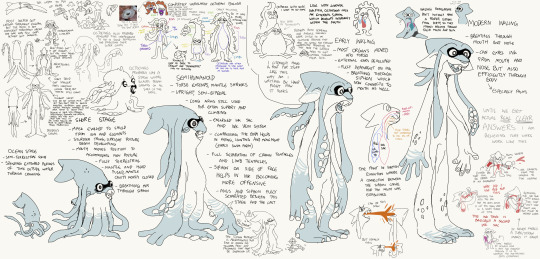
Miscellaneous thoughts dump. mostly about inkling evolution to get the nose thing to stop vexing me but with some random additional things.
#squidthoughts#octarians included because believe it or not they were one of my biggest problems thinking about the siphon/nose thing.#archive
466 notes
·
View notes
Text
Thanks for the tag! This made me realize my playlist is not varied lol
Howl - Florence + the Machine
Almost (Sweet Music) - Hozier
Molecules - Hayley Kiyoko
midnight love - girl in red
A Thousand Years - Christina Perri
Wind in Her Hair - Motorama
Sirens - Lola Marsh
Under a Beltane Sun - Damh the Bard
Church Bells - Carrie Underwood
Don't Stop Me Now - Foxes (Queen cover)
@capybaraonabicycle @chuddle-dollops @gays-in-space @idiot---witch @squidthoughts @outrageousbirb feel free to ignore <3
Tag game - Rules: say ten songs you like all by a different artist, then tag ten different people thank you sm @oswildin for the tag!!! :))) 1. yellow - jodie whittaker
2. grace kelly - mika
3. chasing daylight - NOAHFINNCE
4. pizza cutter - letters to cleo
5. curses - the crane wives
6. ruler of everything - tally hall
7. devil town - cavetown
8. untitled - stillsunrise
9. tranz - gorillaz
10. cabinet man - lemon demon
no pressure tags: @thirteens-pocket-watch, @ppasta-catt, @cosmicallyavg, @starstruckthirteen, @marvellouspinecone, @polypyrite, @thasmin13, @sapphicyazzy, @lil-tumbles, @maglex and anyone else who wants to >:) <3
51 notes
·
View notes
Note
I know that Inkling societies mirror human ones because of plot reasons going back to Alterna, but I've really enjoyed seeing your 'convergent evolution' takes on the biology, so why not apply that same logic to something like, say, architecture? At a glance, sure, Inkopolis and the Splatlands look recognizable to us, but would for instance an inkling or octoling's home have a layout differently built for their unique needs and behavior?
Thank you! also yes this is a good point! I've been avoiding doing anything too outlandish with the architecture or much of any of the worldbuilding to be honest because we know very little about Splatoon architecture and... well, stuff like this, to begin with. And it's harder to try and change major things about the world itself than it is to work with alternative biology for a creature in my opinion; all we really know when it comes to architecture and city- and building design in Splatoon that it is very similar to those of humans, and a lot of the elements are based on modern day Japan. I doubt the developers are doing that much to differentiate the architecture from human buildings and stuff because granted it would be a ridiculous amount of thoughts and work to sculpt a society and buildings that accommodate like 500 different species MINIMUM.... there's some little things here and there, like the Giant Doorways in the Deepsea Metro, but then there's other things like the freaking escalator in Inkopolis Plaza that's literally the width of maybe 1 Inkling and no other species even fits in that. Hell, it's not even the width of TWO PEOPLE which is at least expected of escalators to my knowledge--- anyway....
my point being I don't like to make sweeping differences to human architecture when it comes to Splatoon, because whether I like it or not a LOT of their stuff is just human architecture a little bit to the left. But that doesn't mean you can't make any changes to it, and it also doesn't mean there aren't any changes, those changes just might not be as visible.
Some random things I've thought about: Modern housing in Inkadia has VERY strong windows. Glass in general is very strong in urban environments, especially buildings near Turf War areas for obvious reasons... you don't want people Super Jumping through your window nor your window blasted to smithereens by a Trizooka shot that missed.
In apartment buildings, if there are mail slots on the doors, there's a container on the other side. Prevents people from slinking into your house through the mail slot. Apparently this is a common thing to have in Japan? We just have mail slots or postboxes out in the yard or lobby.
Also to prevent people from slinking into your house: residential buildings have dense grates, nets or spikes in their ventilation shafts. In some older buildings and non-residentials, these might be missing. But without things like this, any Inkling (typically) can just fit straight through a pipe as long as their beak fits in it, so you would end up having guests you maybe don't want.
Quickly about apartments; they're actually a very popular form of living not just for cost-cutting and because there's a fuck ton of residents in Inkadia, but because inkfish are mostly very social and do better surrounded with lots of people living in close quarters. The two most popular types of apartments are single-person ones that are basically just a single-room hole, and bigger apartments that have several small rooms and a community area that are meant for a whole school of squid (usually a friend group) to live in. People who live in the single-person apartments typically just go home to sleep and maybe cook or something... unless you're an introverted squid, or not a squid at all, and just settle for very little when it comes to space.
Inklings ALWAYS have some type of direct heating in their houses, from space heaters to a kotatsu to heated blankets to sun lamps. This is because Inklings are mostly cold-blooded and become very sluggish if their body temperature falls too much (for example from lack of physical activity or from cold room temperature), so there's a focus on keeping one's living quarters comfortably warm. Most lamps marketed for inkfish are actually heat lamps to the point where finding a lamp that Doesn't Make The Room Hot if it's on for too long is kind of hard.
Inklings are pretty vulnerable to dry air due to their thin skin and dependence on humidity to keep them thoroughly hydrated. As a result, you'll find air humidifiers in like, every house. In some AC units, a humidifier function is included. From a human perspective, the average Inkling apartment feels warm and humid - but to them it feels just normal. Due to the relatively high humidity, it's pretty common for electrical outlets to have covers for when they're not in use.
It's common for Octarian homes to have "sleeping holes" or "dens" carved into the wall. These haven't really become trendy in Inkopolis yet, but they probably will. It's also quite common for inkfish homes to have stacked furniture and interior made in layers - because they can fit in very tight spaces in swim form, maze-like interiors are still fully usable to most inkfish. Though it's rarer to find people who actually want to deal with the clutter.
Most Inkopolis bathrooms have a combined shower-bath. Inkfish showers come with a shower head that only really lets mist through on the default setting. (You're expected to test this BEFORE you take your first shower and replace it if necessary because you don't want to get into the tub and then find out it's a normal cross-species shower head on fucking Jet Mode.) Bathtubs are mainly used for re-absorbing moisture and soaking in ink rather than cleaning (because inkfish don't do very well with actual baths).
Most flooring is specifically made to be ink-resistant and non-absorptive. The combined humidity of the air and the ink that inkfish naturally get everywhere would ruin wooden floors IMMEDIATELY.
Toilets usually have a flap or gate blocking the drain that flips open when it's flushed. There are too many historical cases of people falling into toilets and just fucking dying or going missing forever because it's difficult to get out. (Mostly kids, but also people who fell asleep or too far into thought and just slinked into there. The world is full of danger when you can fit into any gap.) also lots of people accidentally laying eggs there which for obvious reasons is REALLY BAD if there's nothing to catch those.
All modern apartment buildings are required to have elevators. I'm pretty sure this is also just a real-life requirement nowadays. A lot of older buildings in Inkopolis don't have any, though... and while Super Jumping on street level is usually prohibited, most apartments have roof access, so a lot of people still jump between work/hobbies and their house. It is A LOT faster than dealing with traffic or walking (but it's also mostly illegal).
uh probably more things. My brain is empty now but hopefully that's some kind of inspiring ty for asking!
177 notes
·
View notes
Text
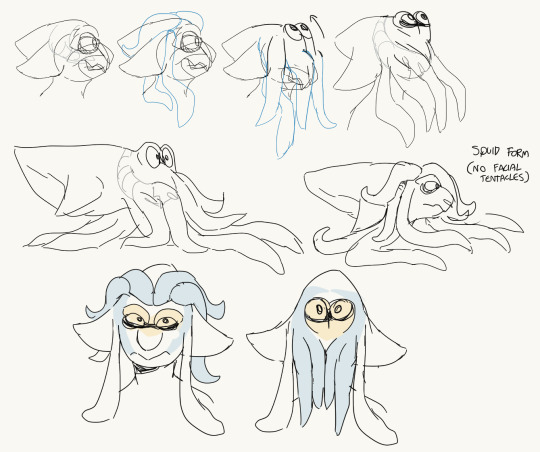
this is like nothing but if it saves somebody else 10 hours of headache and grief then it's worth posting.
169 notes
·
View notes